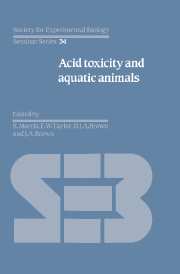Book contents
- Frontmatter
- Contents
- Contributors
- Units, Symbols and Formulae
- Preface
- Introduction: The causes and consequences of surface water acidification
- Invertebrate communities in acid streams
- Fish survival in acid waters
- Field studies on fisheries in acid waters in the UK
- Episodic changes in water quality and their effects on fish
- Acid–base regulation in fishes: 1. Mechanisms
- Acid–base regulation in fishes: 2. Biological responses and limitations
- Intracellular pH regulation and the effects of external acidification
- The physiological problems of fish in acid waters
- Laboratory studies on invertebrate survival and physiology in acid waters
- The physiological problems of crayfish in acid waters
- The effects of hydrogen and aluminium ions on fish gills
- The combined effects of pH and trace metals on fish ionoregulation
- Endocrine responses to acid stress in fish
- Commentary and conclusions
- Index
The physiological problems of fish in acid waters
Published online by Cambridge University Press: 05 February 2012
- Frontmatter
- Contents
- Contributors
- Units, Symbols and Formulae
- Preface
- Introduction: The causes and consequences of surface water acidification
- Invertebrate communities in acid streams
- Fish survival in acid waters
- Field studies on fisheries in acid waters in the UK
- Episodic changes in water quality and their effects on fish
- Acid–base regulation in fishes: 1. Mechanisms
- Acid–base regulation in fishes: 2. Biological responses and limitations
- Intracellular pH regulation and the effects of external acidification
- The physiological problems of fish in acid waters
- Laboratory studies on invertebrate survival and physiology in acid waters
- The physiological problems of crayfish in acid waters
- The effects of hydrogen and aluminium ions on fish gills
- The combined effects of pH and trace metals on fish ionoregulation
- Endocrine responses to acid stress in fish
- Commentary and conclusions
- Index
Summary
Introduction
The physiological effects of environmental acid stress on fish have been thoroughly reviewed in recent years (Muniz & Leivestad, 1980a; Fromm, 1980; Haines, 1981; Spry, Wood & Hodson, 1981; Brown, 1982; Leivestad, 1982; Wood & McDonald, 1982; McDonald, 1983a; Howells, Brown & Sadler, 1983; Howells, 1984); there are certainly not enough new data to justify yet another compendium. Instead, I will first summarize our current knowledge on the acute toxic mechanisms of pure acid stress to adult fish, and in so doing attempt to correct the widely held misconception that external water acidity must cause internal acidosis in the animal. By means of this brief summary, I hope to illustrate that external acidity has proven to be an exceptionally useful probe of normal physiological processes in freshwater teleosts. Secondly, I will describe some of our recent findings on the physiological responses to long term, low level acid stress, and acid-aluminium interactions, both of which may have greater ecological relevance than short term acid stress for ultimate survival in the wild.
Acute responses to pure acid stress
Background
Relatively short term depressions to pH = 4.0–4.5, usually as a result of snowpack melt in the spring, or highly acidic runoff in the summer and autumn, have often been observed in natural soft waters of both northern Europe and eastern North America (e.g. Jeffries, Cox & Dillon, 1979; Harvey et al., 1981; Christophersen, Rustad & Seip, 1984; Marmorek et al., 1985).
- Type
- Chapter
- Information
- Acid Toxicity and Aquatic Animals , pp. 125 - 152Publisher: Cambridge University PressPrint publication year: 1989
- 83
- Cited by



